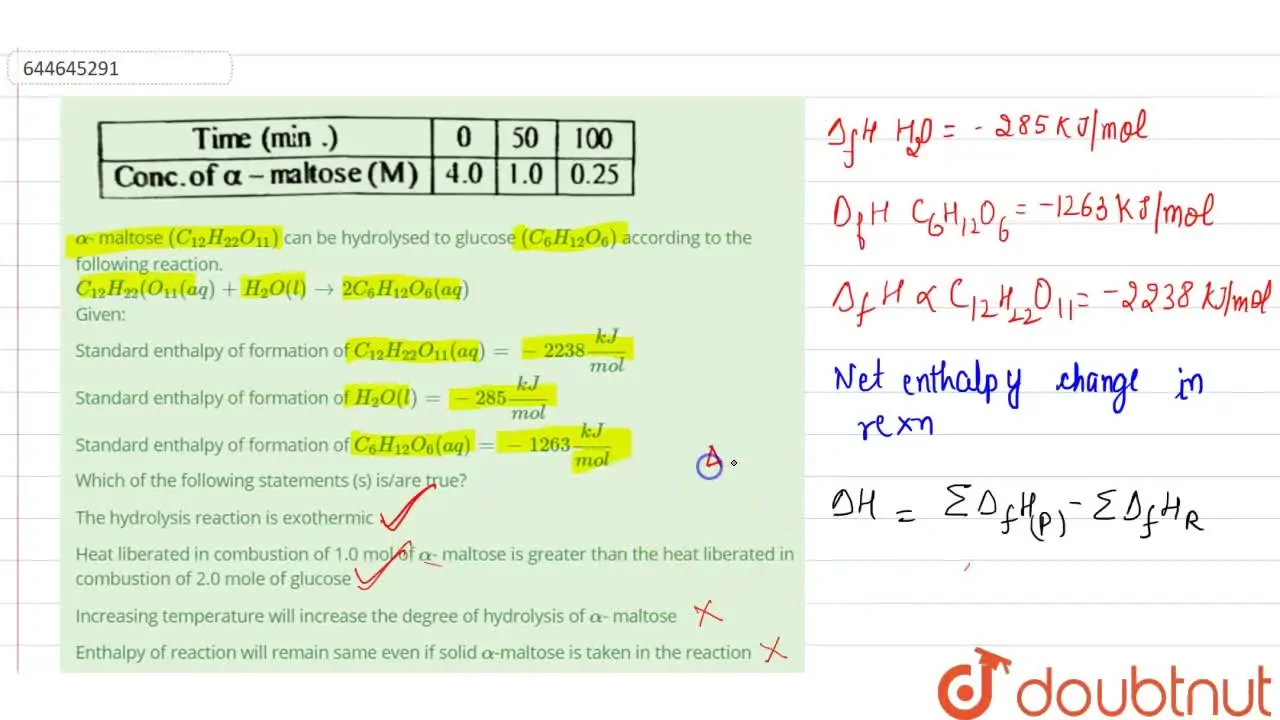
α- maltose (C12H22O11) can be hydrolysed to glucose (C6H12O6) according to the following reaction.
C12H22(O11(aq)+H2O(l)→2C6H12O6(aq)
Given:
Standard enthalpy of formation of C12H22O11(aq)=−2238kJmol
Standard enthalpy of formation of H2O(l)=−285kJmol
Standard enthalpy of formation of C6H12O6(aq)=−1263kJmol
Which of the following statements (s) is/are true?
The hydrolysis reaction is exothermic
Heat liberated in combustion of 1.0 mol of α- maltose is greater than the heat liberated in combustion of 2.0 mole of glucose
Increasing temperature will increase the degree of hydrolysis of α- maltose
Enthalpy of reaction will remain same even if solid α-maltose is taken in the reaction
The correct Answer is:A, B
(a) ΔrH∘=2(−1263)−(−285)−(−2238)=−3⇒Reaction is slightly exothermic.
(B) C12H22O11(aq)+12O2(g)→12CO2(g)+11H2O(l) ΔcH∘1
2C6H12O6(aq.)+12O2(g)→12CO2(g)+12H2O(l) ΔcH∘2
ΔH∘1=2(x)+11(−285)−(−280)−(−2238)=12x−897 and
ΔcH∘2=2(x)+12(−285)−2(−1263)=12x−894
Clearly: ΔcH∘1>ΔcH∘12 [as x will be negative].
( C) Increasing T will shift the reaction in backward d irection. So, ‘h’ of α- maltose will decrease with temperature.
(D) ΔrH∘ will change if solid α- maltose is taken instead of aq.
Related Playlists
- BOOK - VMC MODULES ENGLISHCHAPTER - THERMOCHEMISTRYEXERCISE - JEE MAIN (ARCHIVE)20videos
THERMOCHEMISTRY
- BOOK - VMC MODULES ENGLISHCHAPTER - THERMOCHEMISTRYEXERCISE - JEE ADVANCED (ARCHIVE)31videos
THERMOCHEMISTRY
- BOOK - VMC MODULES ENGLISHCHAPTER - THERMOCHEMISTRYEXERCISE - LEVEL-175videos
THERMOCHEMISTRY
- BOOK - VMC MODULES ENGLISHCHAPTER - THEORY OF SOLUTIONSEXERCISE - JEE Advanced (Archive)31videos
THEORY OF SOLUTIONS
- BOOK - VMC MODULES ENGLISHCHAPTER - THERMODYNAMICSEXERCISE - JEE ADVANCED (ARCHIVE)44videos
THERMODYNAMICS
Similar Questions
360 amu of Glucose (C6H12O6) contains :
View SolutionThe standard enthalpy of formation of octane (C8H18) is −250kJ/mol. Calculate the enthalpy of combustion of C8H18. The enthalpy of formation of CO2(g) and H2O(l) are −394kJ/mol and −286kJ/mol respectively.
View SolutionThe oxidation number of C in glucose (C6H12O6) is
View SolutionThe enthalpy of formation of H2O(l) is -280.70 kJ/mol and enthalpy of neutralisation of a strong acid and strong base is -56.70 kJ/mol. What is the enthalpy of formation of OH− ions?
View SolutionFor the reaction
C6H12(l)+9O2(g)→6H2O(l)+6CO2(g) , ΔH=−936.9kcal
Which of the following is true ?View SolutionThe numbe of hydrogen atoms in 0.9 gm glucose, C6H12O6, is same as
View SolutionFor the following reaction C6H12(aq)+H2(g)⇔C6H14O6(aq)
Which one of the following is not affected by the addition of catalyst ?View SolutionThe molar enthalpies of combustion of C2H2(g),C(graphite) and H2(g)are −1300,−394, and −286kJmol−1, respectively. The standard enthalpy of formation of C2H2(g) is
View SolutionThe conversion of sugar C12H22O11→CO2 is :
View SolutionThe enthalpy of formation of H2O(l) is −285KJmol−1 and enthalpy of neutralization of a stron acid and a strong bas is −55KJmol−1. What is the enthalpy of formation of OH− ions?
View Solution


